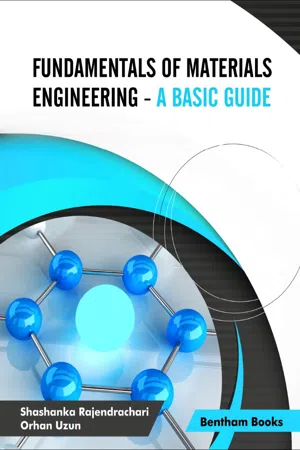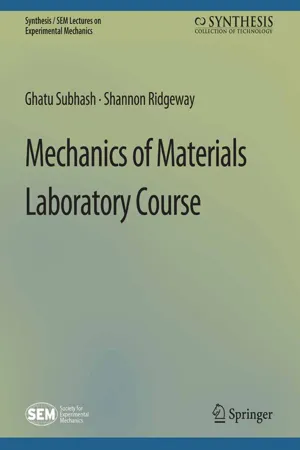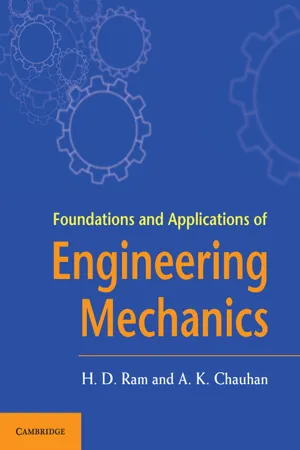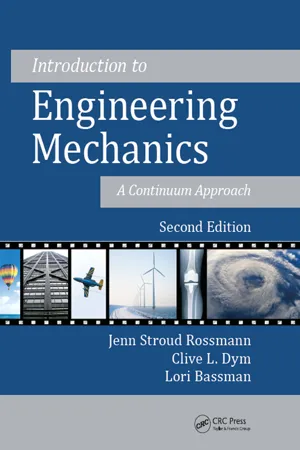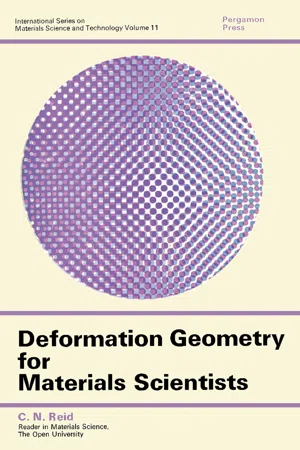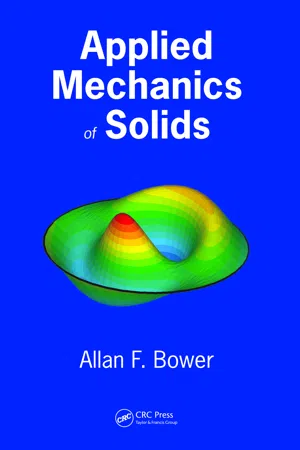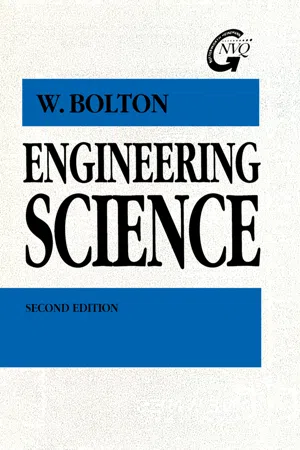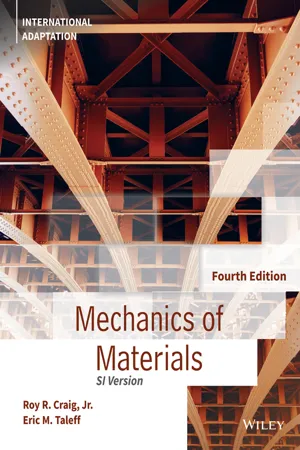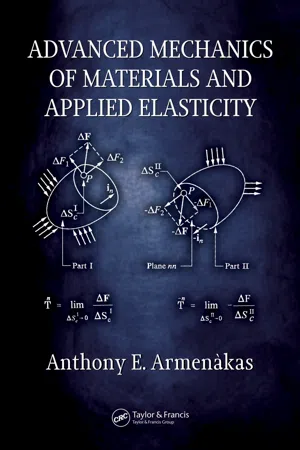Technology & Engineering
Stress Strain Curve
The stress-strain curve is a graphical representation of the relationship between the stress applied to a material and the resulting strain it undergoes. It typically shows the material's behavior under tension, providing valuable information about its mechanical properties such as yield strength, ultimate strength, and ductility. This curve is essential for understanding a material's response to external forces and for designing structures and components.
Written by Perlego with AI-assistance
Related key terms
1 of 5
12 Key excerpts on "Stress Strain Curve"
- eBook - PDF
- William F. Riley, Leroy D. Sturges, Don H. Morris(Authors)
- 2018(Publication Date)
- Wiley(Publisher)
Chapter 4 Material Properties and Stress-Strain Relationships 4-1 INTRODUCTION The satisfactory performance of a structure frequently is determined by the amount of deformation or distortion that can be permitted. A deformation of a few thou- sandths of an inch might make a boring machine useless, whereas the hook on a drag line might deflect several inches without impairing its usefulness. It is often necessary to relate loads and temperature changes on a structure to the deforma- tions produced by the loads and temperature changes. Experience has shown that the deformations caused by loads and by temperature effects are essentially inde- pendent of each other. The deformations due to the two effects may be computed separately and added together to get the total deformation. 4-2 STRESS-STRAIN DIAGRAMS The relationship between loads and deformation in a structure can be obtained by plotting diagrams showing loads and deflections for each member and each type of loading in a structure. However, the relationship between load and deformation depends on the dimensions of the members as well as on the type of material from which the members are made. For example, the graph of Fig. 4-1a (one- dimensional loading) shows the relationship between the force required to stretch three bars of the same material but of different lengths and cross-sectional areas and the resulting deformations of the bars. It is not clear from this graph that these three curves all describe the same material behavior. However, if these curves are redrawn plotting stress versus deformation as in Fig. 4-1b, the data for the first and third bars form a single line. If the curves are redrawn plotting stress versus strain as in Fig. 4-1c, the data for all three curves form a single line. That is, curves showing the relationship between stress and strain (such as Fig. 4-1c) are independent of the size and shape of the member and depend only on the type of material from which the members are made. - Shashanka Rajendrachari, Orhan Uzun(Authors)
- 2021(Publication Date)
- Bentham Science Publishers(Publisher)
Original Gauge Length: Before conducting the tensile tests, two permanent marks are made on the test specimen at an appropriate distance called “Original gauge length”. By subtracting the original gauge length (before the test) with final gauge length (after the test) will give the extent of tensile strength of the tested specimen.3. ENGINEERING STRESS-STRAIN CURVES
The stress-strain curves can be obtained during testing a specimen. As we proceed with the test, the length of the specimen increases and the cross-sectional area decreases; but it is assumed here that dimension remains unchanged. Therefore, engineering stress and engineering strain can be explained by the following equations;The load-bearing capacity of materials is called loadability. This is one of the important mechanical properties which decide the strength of materials. The loadability of materials can be studied by using a tensile testing machine (Universal testing machine) by plotting the engineering stress-strain curve. The engineering stress-strain curve is the same as that of the load-extension diagram. This is because, if the parameters on X-axes and Y-axes are divided by some constants, the original diagram remains unchanged. Therefore, only scales on the X and Y-axes will change, but the original diagram remains unaffected. If we divide the extension (X-axis) by the original gauge length, then the property becomes ‘strain'. Similarly, if we divide the load (Y-axis) by the original area, then the property becomes ‘stress’. Therefore, the load-extension diagram and engineering stress-strain diagrams are the same.4. TRUE STRESS-STRAIN CURVES
During the tensile test, the specimen will be pulled apart slowly under applied load until it breaks. The specimen will behave differently from the start of the test until it breaks. These curves can be plotted by using the values of true stress and true strain generated instant to instant during the tensile test. Therefore, it will undergo different phenomena during the test, and it can be divided into four phases or regions, as illustrated in Fig. () [34- eBook - PDF
- Ghatu Subhash, Shannon Ridgeway, Ghatu Zimmerman(Authors)
- 2022(Publication Date)
- Springer(Publisher)
87 L A B O R A T O R Y 3 Stress–Strain Response of Materials 88 3. STRESS–STRAIN RESPONSE OF MATERIALS PART A: THEORY 3.1 INTRODUCTION Structural components in engineering applications are subjected to complex loads and under- standing the influence of these loads is crucial to their safe design. However, because of the complexity of operating environment, we try to understand the material behavior in simplified loading conditions and then formulate failure theories for deformation behavior under complex combination of loads. To this end, we focus on material deformation under simple uniaxial (1D) tension and compression. Let us review two fundamental concepts in mechanics of materials. (i) Stress: Intensity of internal force at a given point. The intensity is measured as, internal force (P ) divided by area (A) at that location. Note that P is not the external applied force. The internal force is the resultant of all the applied external forces (and moments) acting at that point on a given cross sectional plane. To obtain resultant internal force, a cut section is made at that point and the forces are vectorially summed. For simple uniaxial loading along x-axis on a bar, the stress acting on a plane perpendicular to the loading axis is given by x D P =A (3.1) (ii) Strain: Change in length (dl )/original length (l ). If the change in length is in axial direc- tion x, then " x D dl=l (3.2) In both of the above equations, the denominators A and l refer to either original dimen- sions or current dimensions. If original dimensions are used, then they are called “engineering stress” and “engineering strain,” and if current dimensions are used, they are referred to as “true stress” and “true strain.” To conduct tension test (see Fig. 3.1), we typically use a dog bone-shaped specimen, grip it on two ends, and pull on it. The gage section is assumed to undergo uniform and uniaxial deformation and this deformation (elongation) is measured using an extensometer. - H. D. Ram, A. K. Chauhan(Authors)
- 2015(Publication Date)
- Cambridge University Press(Publisher)
The stress corresponding to point 1 is called proportionality limit. After this point the curve bends towards the strain axis. This implies that the change 542 | Foundations and Applications of Engineering Mechanics in strain in this portion is more than the change in strain for the same change in stress in proportional region. The slope of Stress Strain Curve is equal to the Young’s modulus. 2 Elastic limit: The point 2 on the curve divides the curve into elastic and plastic regions. The stress corresponding to this point is called the elastic limit. If the material is loaded to a stress less than or equal to that of point 2 and removed, the material regains its original shape. In other words, the stress up to point 2 does not cause any permanent or plastic deformation in the body. The material is perfectly elastic up to this point. 3 Yield point: When the stress in the material reaches the stress corresponding to point 3, the resistance to deformation disappears temporarily. This is clear from the portion of the curve between points 3 and 4. Before point 3, the strain changes only when the stress changes. But after point 3, the strain changes without any change in stress. This behaviour of the material is equivalent to surrender to the deformation in physical sense. The deformation completely does not disappear even after removal of the stress. This deformation is called plastic deformation. If the load is removed at point 4, the deformation corresponding to 3-4 will not disappear or in other words will be locked. 4 At point 4 the plastic deformation stops. Further deformation is followed by increase in the stress. The slope of the curve in this region is very small compared to the elastic region. 5 Ultimate stress point: It is the point corresponding to the maximum nominal stress that is reached in the material during the test. The point 5 in the figure shows this point. The stress corresponding to this point is called ultimate stress.- eBook - ePub
Introduction to Engineering Mechanics
A Continuum Approach, Second Edition
- Jenn Stroud Rossmann, Clive L. Dym, Lori Bassman(Authors)
- 2015(Publication Date)
- CRC Press(Publisher)
Figure 2.15 ). This diagram represents the behavior of mild steel, a ductile material. Hooke’s law, as we already know, governs the low-strain regime of the diagram, where stress and strain are linearly related. But what’s going on at higher stress and strain, as the curve bends and ultimately terminates?The point at which the curve is no longer linear, often a plateau on the stress–strain diagram, is called the material’s yield point, defining a yield strength (or yield stress). Generally, beyond the yield point, it takes much less stress to cause much higher strains than in the Hookean region, and, of course the relationship between stress and strain is no longer linear. In some materials, a maximum stress may be reached just before fracture. This is called the ultimate strength (or ultimate stress) of the material. Finally, we see that the curve ends abruptly at a certain stress point. This point represents the stress that would cause the material to rupture or fracture. From Figure 2.14 , we observe that ductile materials can withstand much more strain than brittle materials. We classify materials as ductile or brittle based on their behavior at room temperature; at elevated temperatures, an otherwise brittle material may behave more like a ductile one, while at lowered temperatures, a ductile material may behave like a brittle one.*FIGURE 2.15Idealized stress–strain diagram for mild steel (ductile).Stress–strain curves for various materials are obtained through rigorous testing of the materials’ behaviors in tensile, compressive, and bending tests. The tensile tests are performed in a setup like that shown in Figure 2.2 . Near the breaking point, a specimen of mild steel may resemble the sketch in Figure 2.16 . The narrowing of the specimen at its midpoint is called “necking.” Although the overall cross section of a bar in tension will narrow during elastic deformation (as we will learn in Section 4.1 - eBook - PDF
- J. Beddoes, M. Bibby(Authors)
- 1999(Publication Date)
- Butterworth-Heinemann(Publisher)
Stress and strain during deformation The ingot and continuous casting operations, outlined in the previous chapter, rarely yield a finished product that does not need further processing. Typically, ingots or strands are further processed by one of several bulk deformation operations, often followed by additional shaping via sheet deformation, machining or joining. The prin- ciples that underlie all of these processes are presented in Chapters 4-8. However, to analyse deformation processes, an understanding of the relationships between stress, strain and deformation is necessary. These relationships are presented in this chapter. During metal deformation, large changes in part geometry may occur. It is often important to understand the consequences of the geometrical shape change on the internal structure of the metal. Externally, force and power are applied to deform the part. Internally, the part reacts based on its microstructure and properties. These internal and external effects can usually be quantified to some degree by calcu- lations involving the stress-strain relationships of the workpiece. In this chapter basic stress-strain concepts are briefly introduced to illustrate their usefulness for metal deformation problems. The response of a material to mechanical loads is often measured by a uniaxial tension test. A tensile specimen, such as shown in Fig. 3.1, is loaded with a force, F. The exten- sion of the sample, typically measured by a change in gauge length, is recorded and the results displayed as a load-extension curve. Load-extension curves characteristic of low carbon steel and many nonferrous metals are shown in Fig. 3.1. Since both load and extension are clearly dependent on specimen size, they are not unique mate- rial properties. Consequently, tensile test results are almost always expressed as stress and strain. Engineering stress is defined as F (3.1) O'a = A-~ where: t7 a is the engineering stress - eBook - PDF
Deformation Geometry for Materials Scientists
International Series on Materials Science and Technology
- C. N. Reid, W. S. Owen(Authors)
- 2016(Publication Date)
- Pergamon(Publisher)
CHAPTER 1 T H E C O N C E P T S O F S T R E S S A N D S T R A I N To THE scientist and layman alike, deformation is the process by which a body changes its dimensions in response to impressed forces. We expect the load-bearing capacity to vary with the size of the body, and so the applied forces should be normalised with respect to the dimen-sions of the body. This leads us to the concept of stress. Similarly, the dimensional changes should also be normalised, leading to the definition of strain. Stress and strain are the most intensively used words in the vocabulary of deformation and it is vital that we start with clear definitions of these terms, and a physical visualisation of what they mean. Unfortunately, the words stress and strain are used as alternatives in the vernacular, and most layman are unable to distinguish between them. On the other hand, to the scientist and engineer the terms are quite distinct, and confusion between them is inexcusable. Let us first discuss the concept of stress. STRESS We say that a body is under stress when one part of it exerts forces on neighbouring parts. Perhaps the most obvious examples involve bodies acted on by external forces, such as a chair under the weight of its occupant. However, external forces are not necessary for a state of stress, and bodies can exist in a state of internal stress. For example, suppose that we fully compress a helical spring and then solder together two adjacent turns of the helix. When the external compression is released, these turns will remain stressed, and we say that the spring contains internal stresses. The forces acting within a stressed body are either body forces or surface forces. Gravity is an example of a body force, and its magni-1 2 DEFORMATION GEOMETRY FOR MATERIALS SCIENTISTS tude depends on the volume of the body. Surface forces are exerted on the surfaces of the body by the surroundings, and the magnitude of these forces depends on the surface area of the body. - eBook - PDF
- Allan F. Bower(Author)
- 2009(Publication Date)
- CRC Press(Publisher)
65 3 Constitutive Models: Relations between Stress and Strain The equations listed in Chapter 2 are universal: they apply to all deformable solids. Th ey can-not be solved, however, unless the deformation measure can be related to the internal forces. The constitutive model for a material is a set of equations relating stress to strain (and possibly strain history, strain rate, and other field quantities). Unlike the governing equa-tions in the previous chapter, these equations cannot generally be calculated using fun-damental physical laws (although people are trying to do these calculations). Instead, constitutive models are fit to experimental measurements. Before discussing specific constitutive models, it is helpful to review the basic assump-tions that we take for granted in developing stress-strain laws. They are listed below: A very small sample that is extracted from the solid has uniform properties. When the solid is deformed, initially straight lines in the solid are deformed into smooth curves (with continuous slope), as shown in Figure 3.1. This means that very short line segments (much shorter than the radius of curvature of the curves) are just stretched and rotated by the deformation. Consequently, the • • • Original configuration Deformed configuration e 2 e 1 e 3 FIGURE 3.1 Deformation of an internal material element in a solid. 66 ◾ Applied Mechanics of Solids deformation of a suffi ciently small volume element can be characterized by the defor-mation gradient. The stress at a point in the solid depends only on the change in shape of a vanishingly small volume element surrounding the point. It must therefore be a function of the deformation gradient or a strain measure that is derived from it. If we accept the preceding assumptions, it means that we can measure the relationship between stress and strain by doing an experiment that induces a uniform strain in a suit-able sample of the material. - eBook - PDF
- William Bolton(Author)
- 2016(Publication Date)
- Newnes(Publisher)
6 Stress and strain Stress When a material is subject to external forces, such as those applied to stretch it, then internal forces are set up which oppose the external forces. The material can be considered to be rather like a spring. A spring is stretched by external forces, it sets up internal opposing forces which are readily apparent when the spring is released and they force it to contract. A measure of the intensity of the internal forces in a material created as a result of external forces being applied is stress. Stress is defined as the external force acting per unit area: The unit of stress is the pascal (Pa), where 1 Pa = 1 N/m 2 . Multiples of the pascal are generally used, e.g. the megapascal (MPa) which is 10 6 Pa and the gigapascal (GPa) which is 10 9 Pa. Because the area over which the forces act is more generally mm 2 rather than m 2 , it is useful to recognize that 1 GPa = 1 GN/m 2 = 1 kN/mm 2 and 1 MPa = 1 MN/m 2 = 1 N/mm 2 . The stress is said to be a direct stress when the area being stressed is at right angles to the line of action of the external forces. This is the case with materials in tension or in compression. A material in tension has had its length in the direction of the external forces increased; when in compression it is shortened. The convention is to designate tensile stresses as positive and compressive stresses as negative. Shear stresses are not direct stresses, the forces being applied in the same plane as the area being stressed (see later this chapter). The area used in the calculation of the stress is generally the original area that existed before the stress occurred. This stress is sometimes referred to as the engineering stress. The true stress would be the force divided by the actual area existing in the stressed state. Example 1 A bar of material with a cross-sectional area of 50 mm 2 was subjected to tensile forces of 0.1 kN. - eBook - PDF
Physics of Continuous Matter
Exotic and Everyday Phenomena in the Macroscopic World
- B. Lautrup(Author)
- 2011(Publication Date)
- CRC Press(Publisher)
7 Strain All materials deform when subjected to external forces but different materials react in different ways. Elastic materials bounce back again to the original configuration when the forces cease to act. Others are plastic and retain their shape after deformation. Viscoelastic materials behave like elastic solids under rapid deformation, but creep like viscous liquid over longer periods of time. Elasticity is itself an idealization limited to a certain range of forces. If the external forces become excessive, all materials become plastic and undergo permanent deformation or may even fracture. When a body is deformed, its material is displaced away from its original position. Small deformations are mathematically much easier to handle than large deformations where parts of a body become greatly and non-uniformly displaced relative to other parts, as for example when you crumple a piece of paper. A rectilinear coordinate system embedded in the original body and deformed along with the material of the body becomes a curvilinear coordinate system after the deformation. It can therefore come as no surprise that the general theory of finite deformation is mathematically at the same level of difficulty as general curvilinear coordinate systems. Luckily our buildings and machines are rarely subjected to such violent treatment, and in most cases the deformation may be assumed to be tiny. Although displacement is naturally described by a vector field, the description of defor-mation inevitably leads to the introduction of a new tensor quantity, the strain tensor , which characterizes the state of local deformation or strain in a material. It can come as no surprise that material strain causes tension or stress—as do strained relations among people. In this chapter we shall focus exclusively on the description of strain, and postpone the discussion of the stress-strain relationship for elastic materials to Chapter 8. - Roy R. Craig, Jr., Eric M. Taleff(Authors)
- 2023(Publication Date)
- Wiley(Publisher)
A* B* C* D* E* F* L L* ∆L (b ) The deformed bar. Extensional strain (Fig. 2.5) 2.3-7 2.3-11 Chapter Review 93 Section Suggested Review Problems Section 2.3 also defines thermal strain, the strain that is produced by a change in temperature. = α ΔT where α is the coefficient of thermal expansion and ΔT is the change in temperature from the reference temperature. 2.3-15 2.4 Section 2.4 discusses stress-strain dia- grams and the mechanical properties of materials that are obtained from test- ing tension specimens and compression specimens. L 0 (a) Undeformed specimen. L* (b) Deformed specimen. P P A typical tension-test specimen (Fig. 2.10) A stress-strain diagram is a graph of the results of a tension test (or compres- sion test): stress (σ = P/A) versus strain [ = (ΔL) /L]. From the stress-strain diagram you should be able to determine directly (or calculate) the following mechanical properties: • the proportional limit of the material, • the modulus of elasticity of the mate- rial, • the yield point of the material, and • the ultimate strength of the material. Stress-Strain Diagrams 420 350 280 210 140 70 0.10 0.001 0.20 0.002 0.30 0.003 0.40 0.004 σ U = 441 σ F = 329 (σ YP ) u = 266 (σ YP ) l = 252 σ PL = 245 (mm/mm) σ (MPa) Yielding Strain hardening Necking Elastic behavior Elastic region True fracture stress True stress– true strain ∆ ∆σ σ σ F t σ U σ F (σ YP ) u (σ YP ) l σ PL A B C D E G t G F Plastic behavior (a) (b ) Stress-strain diagrams for structural steel in tension (Fig. 2.11) 2.4-3 The principal design properties of mate- rials are the following: • Strength, • Stiffness, and • Ductility. Define each of these design-related properties; discuss how each is determined from stress-strain diagrams; and discuss how each design property differs from the others. 94 Chapter 2 Stress and Strain Section Suggested Review Problems 2.5 Section 2.5 discusses the differences between elastic behavior and plastic behavior of materials.- Anthony E. Armenakas(Author)
- 2016(Publication Date)
- CRC Press(Publisher)
However, the relations among the components of stress and strain do not depend upon time but upon the direction and path of loading. That is, while elastic deformation depends only upon the initial and final states of stress, the total irreversible time-independent deformation depends upon both the final state of stress and the path of loading. The time-independent behavior of a material subjected to loads beyond the maximum corresponding to elastic response is termed plastic . The mathematical theory concerned with this material behavior is termed plasticity . 3.8 Stress–Strain Relations of Linearly Elastic Materials Subjected to Three-Dimensional States of Stress From the uniaxial tension and the torsion experiments it has been established that for certain engineering materials the relationship among the components of stress and strain is approximately linear, for values of the components of stress below the elastic limit. This result has been extended to three-dimensional states of stress by Robert Hooke and Stress–Strain Relations for Linearly Elastic Materials 129 (3.39) (3.40) (3.41) (3.42) is generally referred to in the literature as Hooke's law. It states that the components of stress, in three-dimensional states of stress, are linearly related to the components of strain. In the most general form, Hooke's law for a body in an environment of constant temperature or for a body thermally isolated from its environment may be written as These relations can be inverted to yield the components of strain as functions of the components of stress ijkl ijkl The coefficients C and S are referred to as the elastic con stants and the elastic compliances , respectively. Generally, they are functions of the space coordinates. In this text we limit our attention to homogeneous materials , that is, materials whose properties ijkl ijkl do not vary from point to point. For these materials, the coefficients C and S are constant throughout the body.
Index pages curate the most relevant extracts from our library of academic textbooks. They’ve been created using an in-house natural language model (NLM), each adding context and meaning to key research topics.

